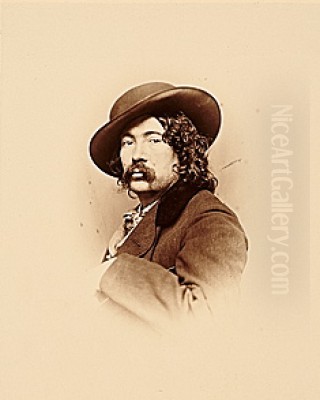
James McDougal Hart (1828-1901) stands as a significant figure in the annals of American art, particularly renowned for his contributions to the second generation of the Hudson River School. Born in Kilmarnock, Ayrshire, Scotland, Hart's artistic journey led him across the Atlantic to become one of the most beloved painters of the American landscape, especially celebrated for his idyllic pastoral scenes featuring contented cattle. His meticulous attention to detail, combined with a romantic sensibility, captured the burgeoning nation's appreciation for its natural beauty and agrarian ideals.
Early Life and Artistic Awakenings
James McDougal Hart was born on May 10, 1828. His family, seeking new opportunities, immigrated to the United States when James was a young child, around 1830 or 1831. They settled in Albany, New York, a bustling city that would serve as the backdrop for Hart's formative years. Like many aspiring artists of his time, Hart's initial foray into the world of craftsmanship was practical rather than purely artistic. He was apprenticed to a coach maker, a trade that required a steady hand and an eye for design, likely honing his skills in decorative painting on panels and ornaments.
During his youth in Albany, Hart also reportedly engaged in sign painting. This type of work, while commercial, provided valuable experience in composition, lettering, and the handling of pigments. It was in this environment that his innate artistic talents began to flourish, prompting him to seek more formal training. His elder brother, William Hart (1823-1894), was also embarking on an artistic career, and the siblings undoubtedly influenced and supported each other's aspirations. The artistic environment of Albany, though not as central as New York City, was nonetheless vibrant enough to nurture young talent.
European Sojourn: The Düsseldorf Influence
Recognizing the need for advanced instruction, James McDougal Hart, like many ambitious American artists of his generation, looked to Europe. Around 1849 or 1850, at the age of approximately twenty-two, he traveled to Germany to study at the prestigious Düsseldorf Academy (Königliche Kunstakademie Düsseldorf). This institution was a magnet for international students, particularly Americans, drawn by its rigorous curriculum and emphasis on precise draftsmanship and detailed realism.
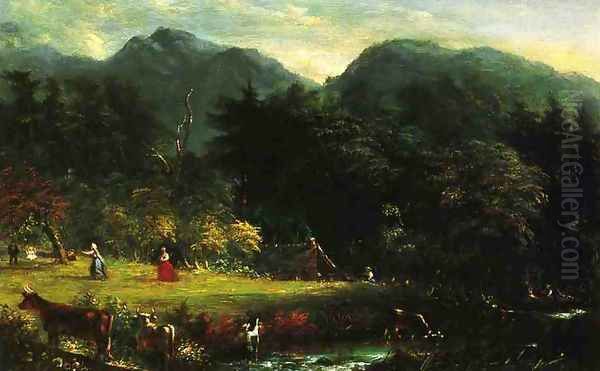
In Düsseldorf, Hart is believed to have studied under the tutelage of Johann Wilhelm Schirmer (1807-1863), a prominent landscape painter and influential professor at the Academy. Schirmer's approach to landscape painting, which combined meticulous observation of nature with an underlying romantic or historical narrative, profoundly impacted Hart. The Düsseldorf School's emphasis on detailed rendering, careful composition, and often a somewhat sentimental or anecdotal quality can be seen in Hart's subsequent work. Other American artists who studied in Düsseldorf around this period, or were influenced by its style, included Albert Bierstadt, Worthington Whittredge, Eastman Johnson, and Emanuel Leutze, creating a transatlantic artistic dialogue. Hart spent approximately three years in Germany, immersing himself in its artistic traditions and honing his technical skills before returning to America.
Return to America and Establishing a Career
James McDougal Hart returned to Albany, New York, in 1853, his European training providing him with a strong foundation and a degree of prestige. He quickly established a studio in Albany and began to build his reputation as a landscape painter. He also took on students, sharing the knowledge he had acquired abroad. His work from this period began to attract attention for its technical proficiency and appealing subject matter.
However, the greater artistic opportunities and a more robust market lay in New York City, which was rapidly becoming the undisputed center of the American art world. In 1857, Hart made the strategic move to New York City, a decision that would prove pivotal for his career. He became actively involved in the city's artistic institutions, most notably the National Academy of Design. He was elected an Associate Member of the National Academy (ANA) in 1857 and achieved full Academician status (NA) in 1858. This recognition by his peers was a significant endorsement of his talent and professional standing. For nearly four decades, Hart would serve the National Academy in various capacities, including as its Vice President for several years, and he was a consistent exhibitor at its influential annual exhibitions until 1900.
The Hudson River School and Hart's Place Within It
James McDougal Hart is firmly associated with the second generation of the Hudson River School, America's first true school of landscape painting. This movement, which emerged in the 1820s with artists like Thomas Cole and Asher B. Durand, celebrated the American wilderness as a source of national pride and spiritual renewal. The first generation often focused on the sublime and untamed aspects of nature, particularly the landscapes of the Hudson River Valley, the Catskill Mountains, and New England.
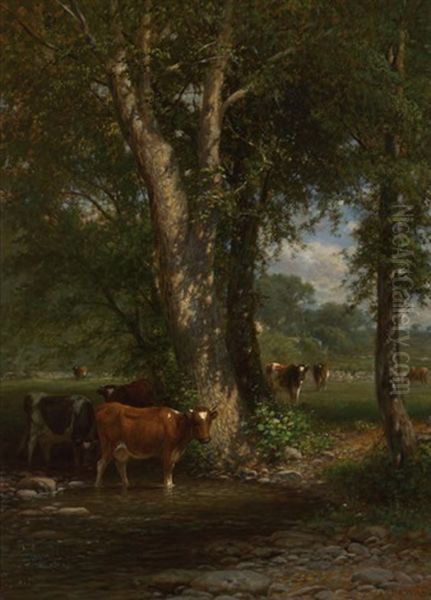
By the mid-19th century, as Hart was establishing his career, the Hudson River School had evolved. While still rooted in a deep appreciation for nature and detailed realism, second-generation artists often expanded their geographical scope and, in some cases, shifted their thematic focus. Artists like Frederic Edwin Church and Albert Bierstadt (who also studied in Düsseldorf) became known for their grand, panoramic depictions of South American jungles, Arctic icebergs, and the American West. Others, like Sanford Robinson Gifford and John Frederick Kensett, were key figures in Luminism, a style characterized by its soft light, hazy atmospheres, and tranquil compositions.
Hart, along with his brother William Hart, carved out a distinct niche within this broader movement. While capable of painting grander vistas, James McDougal Hart became particularly renowned for his more intimate and pastoral scenes. He specialized in depicting the domesticated American landscape – peaceful meadows, gentle streams, and wooded groves, often populated by carefully rendered cattle. These scenes resonated with a public that increasingly valued agrarian life and the picturesque beauty of the countryside, even as the nation was rapidly industrializing. His work offered an idealized vision of harmony between humanity and nature.
Artistic Style, Themes, and Signature Motifs
James McDougal Hart's artistic style is characterized by its meticulous detail, smooth brushwork, and a warm, often golden, light that bathes his scenes in an atmosphere of tranquility. His training at the Düsseldorf Academy instilled in him a commitment to precise draftsmanship and careful observation. This is particularly evident in his rendering of foliage, tree bark, and, most famously, his cattle.
Cattle became a signature motif in Hart's oeuvre. He painted them with an almost portrait-like attention to individual characteristics, reportedly able to distinguish between different breeds in his depictions. His cows are not merely generic staffage but integral elements of his compositions, often shown grazing peacefully, wading in streams, or resting in shaded pastures. These animals symbolized the productivity and serenity of rural life, appealing to the romantic and nostalgic sentiments of his audience. His paintings often evoke a sense of peace, abundance, and the gentle rhythms of the agricultural year.
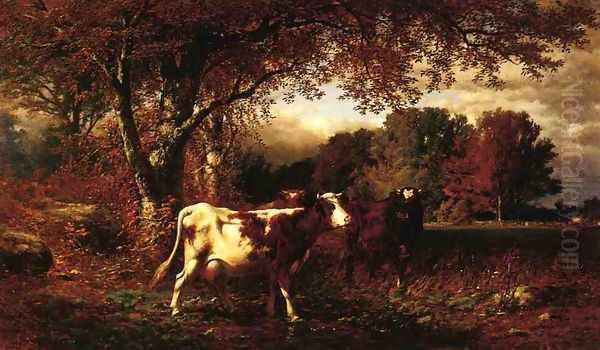
While his brother William Hart also painted landscapes with cattle, James's style was often considered more detailed and perhaps more closely aligned with the Düsseldorf aesthetic in its finish. James favored scenes of gentle, rolling countryside, often in the Catskills, the Berkshires, or other parts of New England and New York State. His compositions are typically well-balanced, leading the viewer's eye through sunlit clearings and into shaded depths, creating a harmonious and inviting vision of nature. He was adept at capturing the specific qualities of light at different times of day, from the bright clarity of midday to the soft glow of late afternoon.
Notable Works and Exhibitions
Throughout his long and productive career, James McDougal Hart created a substantial body of work, much of which was exhibited at the National Academy of Design, the Brooklyn Art Association, and other prominent venues. Some of his paintings achieved considerable contemporary acclaim.
Among his celebrated works are:
"The Old Homestead" (1862): This painting, now in the collection of the High Museum of Art, Atlanta, is a quintessential example of Hart's pastoral idealism. It depicts a charming farmhouse nestled in a lush landscape, with cattle grazing peacefully in the foreground, embodying the American dream of rural self-sufficiency and domestic tranquility.
"Summer Memory of Berkshire" (also known as "A Summer Memory of Berkshire" or sometimes referred to by variations like "Catskill Summer"): This title, or variations of it, refers to works that capture the idyllic beauty of the New England or New York countryside in summer. These paintings typically feature lush greenery, tranquil waters, and, of course, his signature cattle. One such work gained attention when exhibited.
"Indian Summer" (circa 1870s): This theme, popular among Hudson River School painters, allowed Hart to explore the rich, hazy light and autumnal colors characteristic of this season in North America. His renditions would have emphasized the beauty and tranquility of the landscape during this specific time of year. Works with this title were exhibited, including at the Paris Salon in 1878, which was a significant international recognition for an American artist.
"Peaceful Valley" or "Cattle in a Stream": Many of Hart's paintings carry titles that directly reflect their serene subject matter. Works depicting cattle cooling themselves in a stream or grazing in a sun-dappled valley were hallmarks of his output and highly sought after by collectors.
"Landscape with Cattle": This generic title applies to numerous works by Hart, each showcasing his skill in combining detailed animal painting with evocative landscape settings. The High Museum of Art, for example, holds a "Landscape with Cattle" from 1877 that exemplifies his mature style.
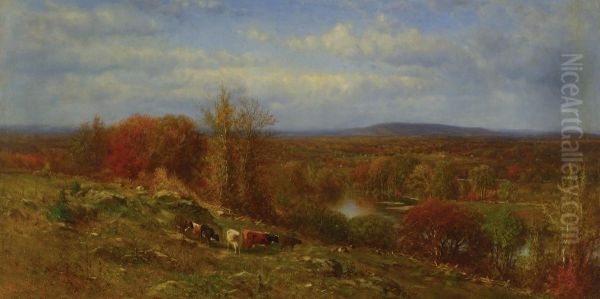
His participation in international exhibitions, such as the Paris Salon, helped to raise the profile of American landscape painting abroad. At home, his works were popular with the growing class of wealthy industrialists and merchants who sought to adorn their homes with images that celebrated American nature and traditional values.
Collaborations and Artistic Circle
James McDougal Hart was an active member of the New York art community. His closest artistic associate was undoubtedly his brother, William Hart. While they pursued independent careers, their shared artistic inclinations and frequent exhibition in similar circles created a strong familial bond within the Hudson River School. Their sister, Julie Hart Beers Kempson (1835-1913), also became a recognized landscape painter, one of the few professional female artists in this genre during the period, making the Harts a notable artistic family.
James McDougal Hart also engaged in collaborations. He is known to have worked with Arthur Fitzwilliam Tait (1819-1905), a British-born American artist renowned for his paintings of animals and sporting scenes. In these collaborations, Tait would typically paint the animals, while Hart would provide the landscape settings. This partnership leveraged the specialized skills of both artists, resulting in dynamic and highly detailed compositions.
Beyond these direct collaborations, Hart would have interacted with many of his Hudson River School contemporaries, including figures like Sanford Robinson Gifford, John Frederick Kensett, Jasper Francis Cropsey, and William Trost Richards. He would also have known artists who, like him, had connections to the Düsseldorf School, such as Albert Bierstadt and Worthington Whittredge. The National Academy of Design served as a central meeting point for these artists, fostering a sense of community and shared purpose.
The Hart Artistic Dynasty
The artistic inclinations within the Hart family extended beyond James, William, and Julie. James McDougal Hart married Marie Theresa Gorsuch in 1866. She, too, was an artist, reportedly a painter of still lifes. This shared passion for art undoubtedly enriched their family life.
Their artistic legacy continued into the next generation. Several of their children also became painters:
Letitia Bonnet Hart (1867-1953) became known for her figure paintings and portraits, exhibiting a style distinct from her father's landscapes.
Mary Theresa Hart (1872-1942) also pursued a career as a painter, often focusing on still lifes and figurative subjects.
William Gorsuch Hart (dates vary, c. 1873- c. 1937 or later), their son, also became an artist.
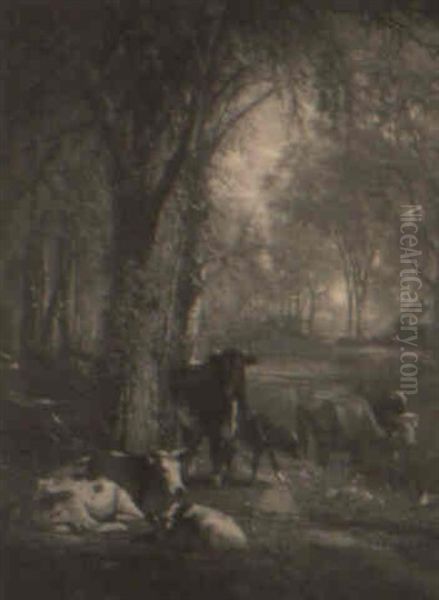
Another son, Robert Gorsuch Hart, is sometimes mentioned as an artist, though less information is readily available about his career.
This continuation of artistic pursuits within the family underscores the creative environment that James McDougal Hart and his wife fostered.
Later Career, Changing Tastes, and Legacy
James McDougal Hart enjoyed a long and successful career, remaining a popular and respected figure in American art for much of the late 19th century. He continued to paint his signature pastoral landscapes, which found a ready market among patrons who appreciated their technical skill and reassuringly idyllic visions of America. He maintained his studio in New York City and later had a summer home and studio in Keene Valley, in the Adirondack Mountains, a region popular with many landscape painters.
However, by the late 19th century, artistic tastes began to shift. The rise of Impressionism, with its emphasis on capturing fleeting moments, subjective perception, and looser brushwork, presented a challenge to the detailed realism of the Hudson River School. Artists like Childe Hassam, Theodore Robinson (who was influenced by French Impressionism), and John Henry Twachtman began to gain prominence. While Hart's work continued to be exhibited and collected, the dominance of the Hudson River School aesthetic gradually waned.
Despite these changing tides, James McDougal Hart's contributions remained significant. He, along with his contemporaries, had played a crucial role in establishing landscape painting as a major genre in American art. His works celebrated the beauty of the American countryside and helped to shape a national artistic identity.
James McDougal Hart passed away on October 24, 1901, in Brooklyn, New York, at the age of 73. He was buried in Green-Wood Cemetery in Brooklyn, a historic resting place for many notable New Yorkers, including fellow artists.

Today, James McDougal Hart's paintings are held in the collections of major American museums, including the Metropolitan Museum of Art in New York, the National Gallery of Art in Washington, D.C., the High Museum of Art in Atlanta, the Brooklyn Museum, the Wadsworth Atheneum in Hartford, Connecticut, and many others. His work is appreciated for its technical mastery, its charming depiction of rural life, and its embodiment of 19th-century American pastoral ideals. He remains a key figure for understanding the development of the Hudson River School and the broader currents of American art in his time. His legacy is that of a dedicated and skilled artist who beautifully captured a vision of America that continues to resonate with viewers.